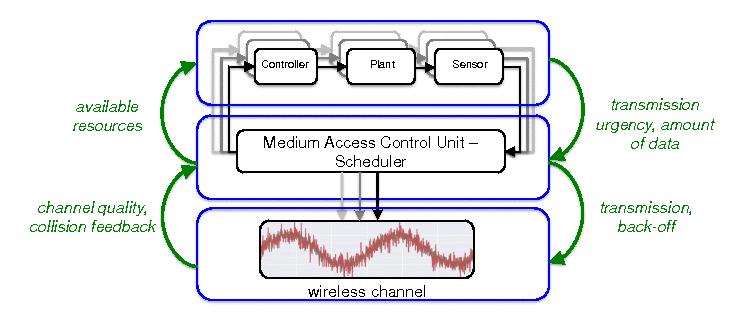Optimal Co-Design of Wireless Resource Management and Multi-Loop Networked Control

| Funding Agency | DFG |
| Duration: | 3 + 3 years, 01.09.2016 - 31.12.2022 |
| Partners: | Chair of Information-oriented Control (TUM-ITR) |
| Contact: | Onur Ayan (onur.ayan@tum.de) |
| Samuele Zoppi (samuele.zoppi@tum.de) | |
| W. Kellerer (wolfgang.kellerer@tum.de) | |
| Publications |
Scope of Project
Emerging cyber-physical systems (CPS) such as smart industrial production lines, smart energy grids, and autonomous vehicular systems are characterized by multiple feedback control loops that are closed over a shared communication channel. This poses new challenges for the communication and control system design to support such networked control systems (NCS) with stringent real-time requirements. Network design has to move from traditional throughput-oriented optimization of network resources to real-time orientation to support NCS. Control systems in turn need to become aware of the changing conditions and opportunities of the network infrastructure. A strictly separate design is known to lead to high conservatism and thus to a low quality of control and to low efficiency and high cost in the context of resource usage. So, future CPS design needs to address control and networking jointly to efficiently fulfill the tight control performance requirements. Today, there exists no systematic approach for the joint design of the control and communication protocol.
The objective of this project is to develop a framework for the co-design of communication and control, concretely for the optimal co-design of the wireless resource management in terms of medium access control and networked multi-loop control. Our key contributions are:
- a deep understanding of the relationship between the achievable control performance, communication network parameters and control system parameters based on analytic models
- novel optimal control and scheduling designs under resource constraints
- novel mechanisms for medium access in multi-hop wireless networks with real-time requirements
- a (near-) optimal layering architecture and co-design for wireless communication and control over wireless multi-hop networks.
We take the scenario of multiple independent control loops accessing one shared wireless communication channel as our starting point. In particular, we consider control systems with heterogeneous linear time invariant processes and a typical wireless network medium access control based on a slotted aloha principle. We investigate the wireless network resource management and control performance trade-off, propose new models for a joint consideration and explore their fundamental limits in terms of scale and performance. Based on the decomposition of the overall optimization problem, we derive a novel approach for the control and scheduling design as well as new network resource management schemes to support a co-design. We provide a first optimal system co-design through the solution of the decomposed optimization problem. A key focus is put on finding fundamental results.

Contributions
- Introduction of novel cross-layer solutions for multi-loop networked control systems (NCS). The focus in control was set on linear-quadratic regulator (LQR) control and network-aware sampling mechanisms.
- Investigation of control-aware medium access control (MAC) mechanisms for single-hop and two-hop networks with packet erasure channel model. Our developed novel cross-layer solutions are able to outperform classical metrics based on throughput, average delay and even the recently proposed age-of-information (AoI) metric.
- Development of an optimal control and communication approach by solving a global optimization problem which maximizes the control performance of multiple feedback control loops sharing a resource constrained communication network. Most importantly we were able to decompose the problem in a distributed fashion without losing optimality.
- Develompent of a lightweight, open-source control and communication platform for testing and benchmarking.
Additional Resources
Funding
This work received funding by the Deutsche Forschungsgemeinschaft (DFG, German Research Foundation) - 315177489.